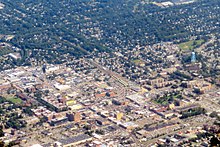ܠܩܚܐ
Appearance
Assyrian Neo-Aramaic
[edit]
Etymology
[edit]Learned borrowing from Classical Syriac, from the archaic verb ܠܩܚ (ləqaḥ, “to take”), referring to an open area around a city and any settlements within its jurisdiction historically supplying the food sources; compare cognate of Hebrew לֶקַח (lékakh, “lesson, moral”).
Pronunciation
[edit]Noun
[edit]ܠܲܩܚܵܐ • (laqḥā) m sg (plural ܠܲܩܚܹ̈ܐ (laqḥē))
Inflection
[edit]| isolated forms | with possessive pronouns | |||||||
|---|---|---|---|---|---|---|---|---|
| state | form | person | singular | plural | ||||
| m | f | |||||||
| singular | absolute | – | 1st person | ܠܲܩܚܝܼ (laqḥī) | ܠܲܩܚܲܢ (laqḥan) | |||
| construct | ܠܩܲܚ (lqaḥ) | 2nd person | ܠܲܩܚܘܼܟ݂ (laqḥūḵ) | ܠܲܩܚܵܟ݂ܝ (laqḥāḵ) | ܠܲܩܚܵܘܟ݂ܘܿܢ (laqḥāwḵōn) | |||
| emphatic | ܠܲܩܚܵܐ (laqḥā) | 3rd person | ܠܲܩܚܹܗ (laqḥēh) | ܠܲܩܚܵܗ̇ (laqḥāh) | ܠܲܩܚܗܘܿܢ (laqḥhōn) | |||
| plural | absolute | – | 1st person | ܠܲܩܚܝܼ̈ (laqḥī) | ܠܲܩܚܲܢ̈ (laqḥan) | |||
| construct | ܠܲܩܚܲܝ̈ (laqḥay) | 2nd person | ܠܲܩܚܘܼ̈ܟ݂ (laqḥūḵ) | ܠܲܩܚܵܟ݂ܝ̈ (laqḥāḵ) | ܠܲܩܚܵܘ̈ܟ݂ܘܿܢ (laqḥāwḵōn) | |||
| emphatic | ܠܲܩܚܹ̈ܐ (laqḥē) | 3rd person | ܠܲܩܚܘܼ̈ܗܝ (laqḥūh) | ܠܲܩܚ̈ܘܿܗ̇ (laqḥōh) | ܠܲܩܚܗ̈ܘܿܢ (laqḥhōn) | |||
Coordinate terms
[edit]- ܡܵܬ݂ܵܐ (māṯā, “village, town”), ܫܒ݂ܵܒ݂ܘܼܬ݂ܵܐ (šḇāḇūṯā, “neighbourhood”), ܡܵܚܘܿܙܵܐ (māḥōzā, “quarter”), ܡܕ݂ܝܼܢ݇ܬܵܐ (mḏītā, “city”), ܦܢܝܼܬ݂ܵܐ (pnīṯā, “area, region”)
See also
[edit]- ܢܲܦܩܝܼܬ݂ܵܐ (napqīṯā)
Classical Syriac
[edit]Alternative forms
[edit]- ܠܚܩܐ (laḥqā)
Pronunciation
[edit]- (Classical Edessan) IPA(key): [ˈlaq.ħɑ]
- (Eastern Syriac) IPA(key): [ˈlaq.xɑ]
- (Western Syriac) IPA(key): [ˈlɑq.ħo]
Noun
[edit]ܠܩܚܐ • (laqḥā) m (plural ܠܩܚܐ (laqḥē))
- open area around a city and any settlements within its jurisdiction: countryside, suburb, metropolitan area, region
- (by extension) far reaches, remote area; hiding place
Inflection
[edit]| isolated forms | with possessive pronouns | |||||||
|---|---|---|---|---|---|---|---|---|
| state | form | person | singular | plural | ||||
| m | f | m | f | |||||
| singular | absolute | ܠܩܚ | 1st person | ܠܩܚܝ | ܠܩܚܢ | |||
| construct | ܠܩܚ | 2nd person | ܠܩܚܟ | ܠܩܚܟܝ | ܠܩܚܟܘܢ | ܠܩܚܟܝܢ | ||
| emphatic | ܠܩܚܐ | 3rd person | ܠܩܚܗ | ܠܩܚܗ | ܠܩܚܗܘܢ | ܠܩܚܗܝܢ | ||
| plural | absolute | ܠܩܚܝܢ | 1st person | ܠܩܚܝ | ܠܩܚܝܢ | |||
| construct | ܠܩܚܝ | 2nd person | ܠܩܚܝܟ | ܠܩܚܝܟܝ | ܠܩܚܝܟܘܢ | ܠܩܚܝܟܝܢ | ||
| emphatic | ܠܩܚܐ | 3rd person | ܠܩܚܘܗܝ | ܠܩܚܝܗ | ܠܩܚܝܗܘܢ | ܠܩܚܝܗܝܢ | ||
References
[edit]- “lqḥ”, in The Comprehensive Aramaic Lexicon Project, Cincinnati: Hebrew Union College, 1986–, retrieved 2019-05-20
- Costaz, Louis (2002) Dictionnaire syriaque-français ∙ Syriac–English Dictionary ∙ قاموس سرياني-عربي, 3rd edition, Beirut: Dar El-Machreq, page 174a
- Payne Smith, Jessie (1903) A Compendious Syriac Dictionary Founded Upon the Thesaurus Syriacus of R. Payne Smith, D.D., Oxford: Clarendon Press, page 244b
- Sokoloff, Michael (2009) A Syriac Lexicon: A Translation from the Latin, Correction, Expansion, and Update of C. Brockelmann's Lexicon Syriacum, Winona Lake, Indiana, Piscataway, New Jersey: Eisenbrauns; Gorgias Press, page 696a
Categories:
- Assyrian Neo-Aramaic terms belonging to the root ܠ ܩ ܚ
- Assyrian Neo-Aramaic terms borrowed from Classical Syriac
- Assyrian Neo-Aramaic learned borrowings from Classical Syriac
- Assyrian Neo-Aramaic terms derived from Classical Syriac
- Assyrian Neo-Aramaic terms with IPA pronunciation
- Assyrian Neo-Aramaic lemmas
- Assyrian Neo-Aramaic nouns
- Assyrian Neo-Aramaic masculine nouns
- aii:Places
- Classical Syriac terms with IPA pronunciation
- Classical Syriac lemmas
- Classical Syriac nouns
- Classical Syriac masculine nouns
- Classical Syriac terms with quotations
